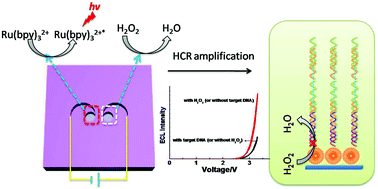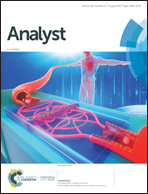Bipolar electrode-electrochemiluminescence (ECL) biosensor based on a hybridization chain reaction
Abstract
A novel electrochemiluminescence (ECL) closed bipolar electrode (BPE) chip was designed based on a hybridization chain reaction (HCR)-induced ECL amplification strategy for the detection of both DNA and H2O2. Without the utilization of a patterned ITO bipolar electrode (BPE), this chip platform consisted of an ITO glass coated with two layers of PDMS slices. The ITO cathode was modified with Au nanoparticles for further functionalization of biomolecules, which could also amplify the ECL signal at the anode of the BPE. Based on the specific hybridization and hybridization chain reaction (HCR), DNA sequences were greatly extended, leading to a significant increase in the resistance of the cathode. The reduction of H2O2 was inhibited on the cathode of the BPE, resulting in a quenching effect on the ECL intensity on the anode of the BPE. The designed biosensor displayed a satisfactory linear relationship for the detection of both DNA and H2O2. Therefore, the biosensor could not only be employed for DNA assays but also used in enzyme reactions based on the generation of H2O2.



 Please wait while we load your content...
Please wait while we load your content...